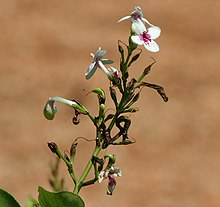Dicots
Acanthaceae
EOL Text
Herbs, shrubs or sometimes climbers. Stipules 0. Leaves opposite, usually entire, less often toothed. Flowers bisexual, actinomorphic or zygomorphic. Bracts and bracteoles usually present. Calyx 4-5-partite, rarely 2-lipped or with 10-18 teeth (Thunbergia). Corolla gamopetalous, 1-2-lipped or 5-lobed. Stamens 2 or 4, inserted on corolla. Anthers 1- or 2-thecous, with thecae together or one above the other. Ovary superior, 2-locular with (1-)2(-3 or more) ovules in each loculus. Fruit a loculicidal capsule, often explosively dehiscent.
| License | http://creativecommons.org/licenses/by-nc/3.0/ |
| Rights holder/Author | Mark Hyde, Bart Wursten, Petra Ballings, Flora of Zimbabwe |
| Source | http://www.zimbabweflora.co.zw/speciesdata/family.php?family_id=1 |
Barcode of Life Data Systems (BOLD) Stats
Specimen Records:1466
Specimens with Sequences:2002
Specimens with Barcodes:1257
Species:593
Species With Barcodes:570
Public Records:880
Public Species:449
Public BINs:0
Barcode of Life Data Systems (BOLDS) Stats
Public Records: 0
Specimens with Barcodes: 5
Species With Barcodes: 1
Barcode of Life Data Systems (BOLDS) Stats
Public Records: 0
Specimens with Barcodes: 3
Species With Barcodes: 1
Acanthaceae is a family (the acanthus family) of dicotyledonous flowering plants containing almost 250 genera and about 2500 species. Most are tropical herbs, shrubs, or twining vines; some are epiphytes. Only a few species are distributed in temperate regions. The four main centres of distribution are Indonesia and Malaysia, Africa, Brazil, and Central America. The representatives of the family can be found in nearly every habitat, including dense or open forests, scrublands, wet fields and valleys, sea coast and marine areas, swamps, and mangrove forests.
Contents
Description[edit]
Plants in this family have simple, opposite, decussated leaves with entire (or sometimes toothed, lobed, or spiny) margins, and without stipules. The leaves may contain cystoliths, calcium carbonate concretions, seen as streaks on the surface.
The flowers are perfect, zygomorphic to nearly actinomorphic, and arranged in an inflorescence that is either a spike, raceme, or cyme. Typically, a colorful bract subtends each flower; in some species, the bract is large and showy. The calyx usually has four or five lobes; the corolla tubular, two-lipped or five-lobed; stamens number either two or four, arranged in pairs and inserted on the corolla, and the ovary is superior and bicarpellated, with axile placentation.
The fruit is a two-celled capsule, dehiscing somewhat explosively. In most species, the seeds are attached to a small, hooked stalk (a modified funiculus called a jaculator) that ejects them from the capsule.
A species well-known to temperate gardeners is bear's breeches (Acanthus mollis ), a herbaceous perennial plant with big leaves and flower spikes up to 2 m tall. Tropical genera familiar to gardeners include Thunbergia and Justicia.
Avicennia, a genus of mangrove trees, usually placed in Verbenaceae or in its own family, Avicenniaceae, is included in Acanthaceae by the Angiosperm Phylogeny Group on the basis of molecular phylogenetic studies that show it to be associated with this family.
Medicinal uses[edit]
Traditionally the most important part use in Acanthaceae is the leaves and they are used externally for wounds. We have found that Acanthaceae possess antifungal, cytotoxic, anti-inflammatory, anti-pyretic, antioxidant, insecticidal, hepatoprotective, immunomodulatory, Anti- platelet aggregation and anti-viral potential.[3]
Phytochemistry[edit]
Phytochemical reports on family Acanthaceae are glycosides, flavonoids, benzonoids, phenolic compounds, naphthoquinone and triterpenoids.[4]
Selected genera[edit]
The 246 accepted genera, according to Germplasm Resources Information Network,are:
|
|
Excluded genera[edit]
- Thomandersia Baill. → Thomandersiaceae[6][7]
References[edit]
| Wikimedia Commons has media related to Acanthaceae. |
| Wikispecies has information related to: Acanthaceae |
- ^ a b c "Family: Acanthaceae Juss., nom. cons.". Germplasm Resources Information Network. United States Department of Agriculture. 2003-01-17. Retrieved 2011-07-29.
- ^ Angiosperm Phylogeny Group (2009). "An update of the Angiosperm Phylogeny Group classification for the orders and families of flowering plants: APG III" (PDF). Botanical Journal of the Linnean Society 161 (2): 105–121. doi:10.1111/j.1095-8339.2009.00996.x. Retrieved 2013-07-06.
- ^ Awan, A.J., Aslam, M.S (2014). "FAMILY ACANTHACEAE AND GENUS APHELANDRA: ETHNOPHARMACOLOGICAL AND PHYTOCHEMICAL REVIEW.". International Journal of Pharmacy and Pharmaceutical Science 6 (10): 44–55.
- ^ Awan, A.J., Aslam, M.S (2014). "FAMILY ACANTHACEAE AND GENUS APHELANDRA: ETHNOPHARMACOLOGICAL AND PHYTOCHEMICAL REVIEW.". International Journal of Pharmacy and Pharmaceutical Science 6 (10): 44–55.
- ^ "Acanthaceae". Integrated Taxonomic Information System. Retrieved 2011-07-29.
- ^ Wortley, A.H., Harris, D.J. & Scotland, R.W.; Harris, D. J.; Scotland, R. W. (2007). "On the Taxonomy and Phylogenetic Position of Thomandersia.". Systematic Botany 32 (2): 415–444. doi:10.1600/036364407781179716.
- ^ "GRIN genera sometimes placed in Acanthaceae". Germplasm Resources Information Network. United States Department of Agriculture. Retrieved 2011-07-29.
- Schwarzbach, Andrea E. and McDade, Lucinda A. (2002). "Phylogenetic relationships of the mangrove family Avicenniaceae based on chloroplast and nuclear ribosomal DNA sequences". Systematic Botany 27: 84–98.
| License | http://creativecommons.org/licenses/by-sa/3.0/ |
| Rights holder/Author | Wikipedia |
| Source | http://en.wikipedia.org/w/index.php?title=Acanthaceae&oldid=645155951 |











